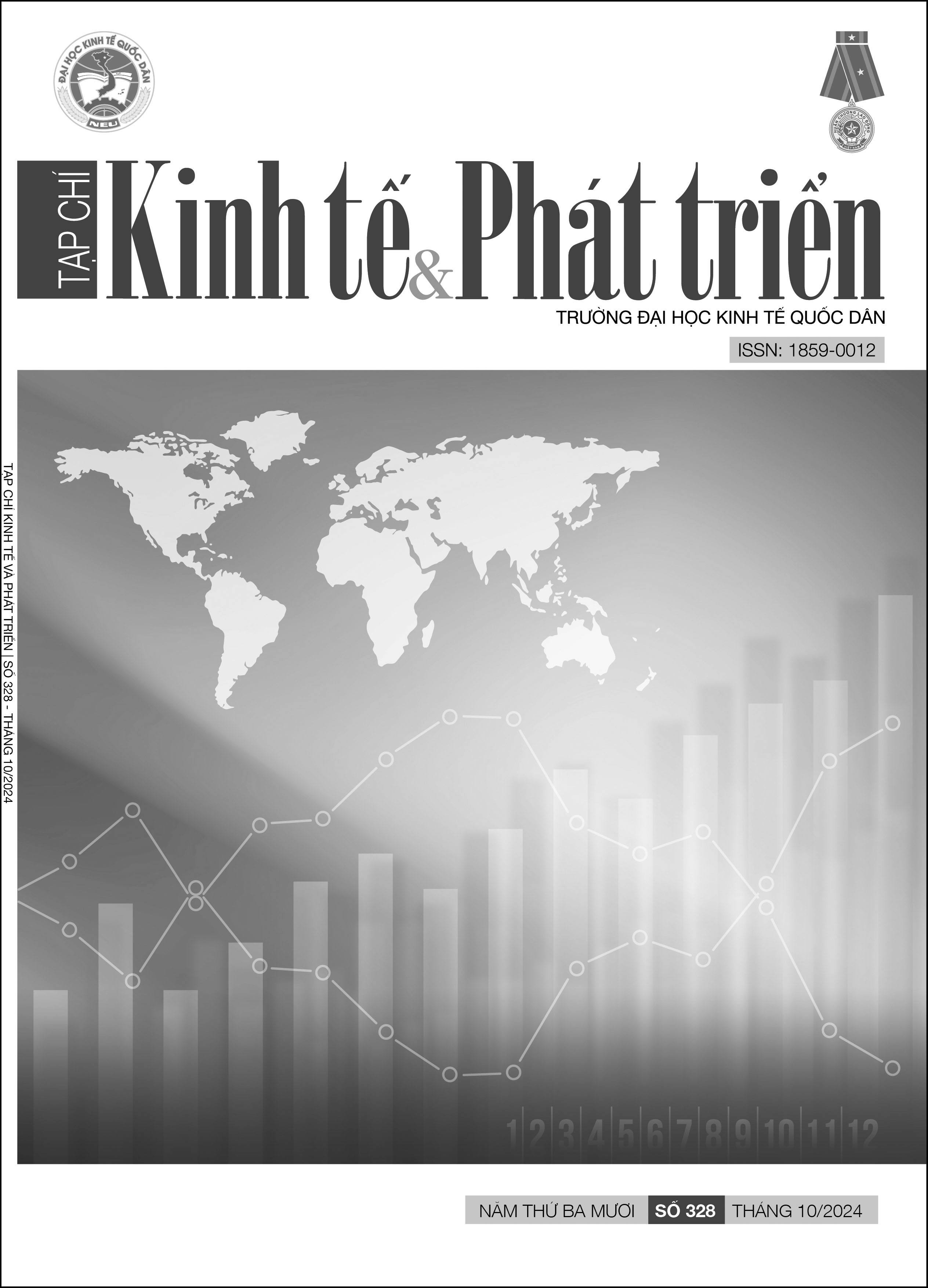Đo lường trình độ dân trí tài chính của sinh viên Việt Nam
DOI:
https://doi.org/10.33301/JED.VI.1810Từ khóa:
dân trí tài chính, thái độ tài chính, hành vi tài chính, kiến thức tài chínhTóm tắt
Vai trò của dân trí tài chính trong bối cảnh hội nhập và phát triển kinh tế đang ngày một được đánh giá cao ở cả các nền kinh tế phát triển và đang phát triển, chiếu theo yêu cầu của sự phổ biến mà đầy phức tạp của các sản phẩm tài chính hiện nay. Trên cơ sở lý thuyết từ các nghiên cứu trước, nghiên cứu này đề xuất một khái niệm thống nhất cho dân trí tài chính - một khái niệm đa chiều với ba nội hàm là thái độ tài chính, hành vi tài chính và kiến thức tài chính. Nghiên cứu sử dụng phương pháp bảng hỏi để thu thập dữ liệu sơ cấp, có cỡ mẫu là 584 sinh viên đang học tập tại các trường đại học của Việt Nam và phân tích bằng phương phápmô hình cấu trúc tuyến tính. Kết quả thu được cho thấy cả ba nội hàm này đều có mối liên hệvới dân trí tài chính, trong đó hành vi tài chính thể hiện sự tương quan lớn nhất, theo sau bởi thái độ tài chính và cuối cùng là kiến thức tài chính.
Tài liệu tham khảo
Atkinson, A. & Messy, F. A. (2012), ‘Measuring financial literacy’, Journal of Consumer Affairs, 44(2), 296-316.
Bhushan, P. & Medury, Y. (2013), ‘Financial Literacy and its Determinants’, International Journal of Engineering, Business and Enterprise Applications, 4(2), 155-160.
Bowen, C. F. (2002), ‘Financial Knowledge of Teens and Their Parents’, Financial Counseling and Planning, 13(2), 93-102.
Bumcrot, C. B., Lin, J., & Lusardi, A. (2013), ‘The Geography of Financial Literacy’, Numeracy: Advancing Education in Quantitative Literacy, 6(2). DOI: http://dx.doi.org/10.5038/1936-4660.6.2.2.
Brüggen, E. C., Hogreve, J., Holmlund, M., Kabadayi, S., & Löfgren, M. (2017), ‘Financial well-being: A conceptualization and research agenda’, Journal of Business Research, 79, 228-237.
Fornell, C., & Larcker, D. F. (1981), ‘Evaluating structural equation models with unobservable variables and measurement error’, Journal of Marketing Research, 18(1), 39-50.
Hair, J. F., Black, W. C., Babin, B. J. & Anderson, R. E. (2009), Multivariate Data Analyses, 7th ed., Pearson, New Jersey.
Hastings, J. S., Madrian, B. C. & Skimmyhorn, W. L. (2013), ‘Financial literacy, financial education, and economic outcomes’, Annual Review of Economics, 5(1), 347-373.
Hilgert, M. A., Hogarth, J. M. & Beverly, S. G. (2003), ‘Household Financial Management: The Connection Between Knowledge and Behavior’, Federal Reserve Bulletin, 89, 309-322.
HM Treasury (2007), Financial capability: The Government’s long-term approach, HMSO, London.
Hulland, J. (1999), ‘Use of partial least squares (PLS) in strategic management research: A review of four recent studies’, Strategic Management Journal, 20(2), 195-204.
Hung, A., Parker, A. M. & Yoong, J. (2009), Defining and Measuring Financial Literacy, RAND Working Paper Series WR-708.
Huston, S. (2010), ‘Measuring financial literacy’, Journal of Consumer Affairs, 44(2), 296-316.
Kadoya, Y. & Khan, M. S. R. (2020), What determines financial literacy in Japan. Journal of Pension Economics and Finance, 19(3), 353-371. DOI: https://doi.org/10.1017/S1474747218000379.
Kempson, E. (2009), Framework for the development of financial literacy baseline surveys: A first international comparative analysis, OECD Working Papers on Finance, Insurance and Private Pensions, No.1 OECD Publishing. DOI: https://doi.org/10.1787/20797117.
Khúc Thế Anh (2020), ‘Dân trí tài chính của người nghèo tại khu vực nông thôn Việt Nam’, Luận án tiến sĩ, Trường Đại học Kinh tế Quốc dân, Hà Nội.
Khan, M. N., Rothwell, D. W., Cherney, K., & Sussman, T. (2017), ‘Understanding the Financial Knowledge Gap: A New Dimension of Inequality in Later Life’, Journal of Gerontological Social Work, 60(6-7), 487–503.
Lusardi, A., & Mitchell, O. S. (2008). Planning and financial literacy: How do women fare?. American Economic Review, 98(2), 413-417.
Lusardi, A. & Tufano, P. (2009), Debt Literacy, Financial Experiences, and Overindebtedness, NBER Working Paper Series, 1-44.
Lusardi, A., Mitchell, O. S. & Curto, V. (2010), ‘Financial Literacy among the Young’, Journal of Consumer Affairs, 44(2), 358-380.
Lusardi, A., & Mitchell, O. S. (2011), Financial Literacy and Planning: Implications for Retirement Wellbeing, National Bureau of Economic Research, Cambridge, MA.
Miller, M., Godfrey, N., Levesque, B., & Stark, E. (2009), The case for financial literacy in developing countries: Promoting access to finance by empowering consumers, World Bank, DFID, OECD, and CGAP joint note, World Bank, Washington, DC.
Nguyen, T. A. N., Rózsa, Z., Belás, J., & Belásová, L. (2017), ‘The effects of perceived and actual financial knowledge on regular personal savings: Case of Vietnam’, Journal of International Studies, 10(2), 278-291.
Noctor, M., Stoney, S. & Stradling, R. (1992), Financial literacy: a discussion of concepts and competencies of financial literacy and opportunities for its introduction into young people’s learning, National Foundation for Educational Research, London.
OECD (2005), Improving Financial Literacy: Analysis of Issues and Policies, OECD Publishing, Paris. DOI: https://doi.org/10.1787/9789264012578-en.
OECD (2017), G20/OECD INFE report on adult financial literacy in G20 countries, OECD Publishing, Paris. DOI: https://doi.org/10.1787/04fb6571-en.
OECD (2022), OECD/INFE Toolkit for Measuring Financial Literacy and Financial Inclusion 2022, OECD Publishing, Paris. DOI: https://doi.org/10.1787/cbc4114f-en.
Ozdemir, M., Sari, A. L. & Irwandi, I. (2021), ‘The influence of motivation, financial literacy, and social media financial platforms on student investment interest’, Komitmen: Jurnal Ilmiah Manajemen, 2(2), 68-82.
Potrich, A. C. G., Vieira, K. M. & Mendes-Da-Silva, W. (2016), ‘Development of a financial literacy model for university students’, Management Research Review, 39(3), 356-376.
Rai, K., Dua, S. & Yadav, M. (2019), ‘Association of Financial Attitude, Financial Behaviour, and Financial Knowledge Towards Financial Literacy: A Structural Equation Modeling Approach’, FIIB Business Review, 8(1), 51–60.
Shahryar, S., & Tan, S. T. (2014), ‘Spending behaviour of a case of Asian university students’, Asian Social Science, 10(2), 64-69.
Van Rooij, M., Lusardi, A., & Alessie, R. (2011), ‘Financial literacy and stock market participation’, Journal of Financial Economics, 101(2), 449-472.
Zarcadoolas, C., Pleasant, A. & Greer, D. S., (2006), Advancing health literacy: A framework for understanding and action, John Wiley & Sons.





